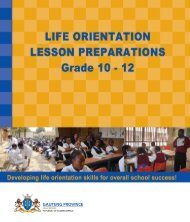Life Science Grade 11
Life Science Grade 11
Life Science Grade 11
You also want an ePaper? Increase the reach of your titles
YUMPU automatically turns print PDFs into web optimized ePapers that Google loves.
<strong>Grade</strong> <strong>11</strong> <strong>Life</strong> <strong>Science</strong>s Lesson Plansthroughout the organism’s bodyArthropoda and Chordata• The phylum Arthropoda is the largest of all phyla andcontains a wide variety of organisms such as chilapods(centipedes), diplopods (millipedes), crustaceans (crabsand shrimp), arachnids ( spiders and scorpions) andinsects (bees, butterflies, grasshoppers)• The phylum Chordata are characterised by thepresence of a notochord (primitive spine)• Chordates may be vertebrates which possess a spinalcolumn• Examples of vertebrates are Osteichthyes (bony fish),Chondrichthyes (cartilaginous fish), Amphibia (frogs),Reptilia (snakes and lizards), Aves (birds) and Mammalia(humans, rats, whales)• Both Arthropods and Chordates are found in a widevariety of habitats and may be aquatic or terrestrial• Both Arthropods and Chordates are bilaterallysymmetrical, triploblastic with a coelom and have athrough gut• The coelom in arthropods is greatly reduced andcontains reproductive organs and large blood – filledspaced called haemocoels (open blood system)2.3 Conclusion• Allow learners to provide feedback on the variousanimal phyla.HomeworkTextbook activityLearners provide feedback on their tables.5 min5 minSolutions for all classroom activity 6p104, Classroom activity 7 p 106,classroom activity 8 p107Understanding <strong>Life</strong> <strong>Science</strong>s Activity1.3.5 p97; Activity 1.3.6 p99, Activity1.3.7 p100Understanding <strong>Life</strong> <strong>Science</strong>s Acitvity1.3.4 p95Term 1 Page 76© Gauteng Department of Education (CAPS version)







